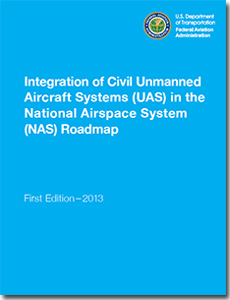Integration of Civil Unmanned Aircraft Systems (UAS) in the National Airspace System (NAS) Roadmap
Expanding Operations of Unmanned Aircraft Systems in the NAS.
Since the early 1990s, unmanned aircraft systems (UAS) have operated on a limited basis in the National Airspace System (NAS). Until recently, UAS mainly supported public operations, such as military and border security operations.
The list of potential uses is now rapidly expanding to encompass a broad range of other activities, including aerial photography, surveying land and crops, communications and broadcast, monitoring forest fires and environmental conditions, and protecting critical infrastructures. UAS provide new ways for commercial enterprises (civil operations) and public operators to enhance some of our nation’s aviation operations through increased operational efficiency and decreased costs, while maintaining the safety of the NAS.
As stated in Destination 2025 (2011):
“The Federal Aviation Administration’s (FAA) mission is to provide the safest, most efficient aviation system in the world. What sets the United States apart is the size and complexity of our infrastructure, the diversity of our user groups, our commitment to safety and excellence, and a history of innovation and leadership in the world’s aviation community. Now we are working to develop new systems and to enhance a culture that increases the safety, reliability, efficiency, capacity, and environmental performance of our aviation system.”
The FAA created the Unmanned Aircraft Systems Integration Office to facilitate integration of UAS safely and efficiently into the NAS. Toward that goal, the FAA is collaborating with a broad spectrum of stakeholders, which includes manufacturers, commercial vendors, industry trade associations, technical standards organizations, academic institutions, research and development centers, governmental agencies, and other regulators.
Ultimately, UAS must be integrated into the NAS without reducing existing capacity, decreasing safety, negatively impacting current operators, or increasing the risk to airspace users or persons and property on the ground any more than the integration of comparable new and novel technologies. Significant progress has been made toward UAS-NAS integration, with many challenges and opportunities ahead.
What’s Related




Favorites





